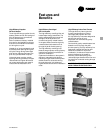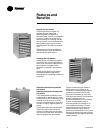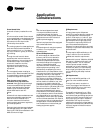
UH-PRC002-EN10
Application
Considerations
Power Vented Units
Units with a factory installed flue vent
fan.
1
All units must be vented. Power vented
units are designed to use single wallvent
pipe. A Breidert Type L, Field Starkap, or
equivalent unit vent cap must be
furnished by the customer.
2
The venting system for these appliances
shall terminate at least 4 feet below, 4
feet horizontally from, or 1 foot above
any door, window or gravity air inlet into
any building.
3
Through-the-wall vents for these
appliances shall not terminate over
public walkways or over an area where
condensate or vapor could create a
nuisance or hazard or could be
detrimental to the operation of
regulators, relief valves, or other
equipment.
4
The vent pipe diameter must be as
shown under “Recommended Flue Size”
in the specification charts. An adaptor
must be field supplied if required.
5
Each furnace must have an
individual vent pipe and vent
terminal. Vent pipe equivalent length
must not exceed 50 feet. Equivalent
length is the total length of straight
sections, plus 15 feet for each 90°
elbow and 8 feet for each 45°
elbow.
6
Maintain 6 inch clearance between vent
pipe and combustible materials. Vent
terminal must be installed with a
minimum clearance of 4 feet from
electric meters, gas meters, regulators,
and relief equipment.
7
Seal vent pipe joints to prevent leakage.
Use General Electric RTV-108 or Dow
Corning RTV-732 Silicone Sealant or 3M
#425 aluminum foil tape.
8
Pitch horizontal pipes downward
¼-inch per foot toward outlet for
condensate drainage. Horizontal
portions of the venting system shall be
supported at maximum intervals of
4 feet to prevent sagging.
9
Vertical vent pipes should be equipped
with condensate drains.
10
Insulate single wall vent pipe exposed
to cold air or running through
unheated areas.
FM and IRI Requirements
IRI, which stands for Industrial Risk
Insurers, and FM, which stands for
Factory Mutual, are both basically
insurance companies which insure
commercial/industrial firms against a
variety of losses. Both publish
requirements which must be met by
certain equipment operating in the
facilities they are preparing to insure.
Listed below is our interpretation of the
requirements of both insurers pertaining
to heating units only to the extent of
features/controls required by IRI and/or
FM. There are a number of additional
requirements which pertain to electrical
service, details of installation, etc., and
we urge you to obtain copies of the
publications pertaining to these details if
you are involved in a job where IRI or FM
adherence has been indicated. The
requirements detailed herein are our
interpretations of the latest publications
in our possession and we must disclaim
any responsibility for errors due to our
interpretation and/or lack of any updated
revision of these standards. Our intent is
to provide you with an understanding of
the application of these standards and
how we believe our indirect-fired gas
heating equipment applies.
IRI Requirements
1
All input sizes require 100 percent
shutoff. This requires that any natural gas
unit, equipped with intermittent pilot
ignition, must employ a “lock out” type
ignition system which will shut off pilot
gas if the pilot fails to light at any time.
This system is required by AGA on LP
gas units as standard equipment.
However, for natural gas units, you need
to specify on the order “Natural Gas, 100
percent shutoff.”
2
All units require AGA certification or UL
“listed” controls. Our units are AGA
certified and meet this requirement.
3
Models with inputs of 150,000 to 400,000
Btu require “mechanical exhaust” and
a “safety interlock.” For our units this
means a power vented or drafter
equipped unit. In both instances, if the
flue vent fan (factory or field installed)
does not get up to speed, the unit will
not fire, satisfying the safety interlock
portion.
FM Requirements
1
All units must be AGA certified or UL
listed. Our units are AGA certified.
2
The high limit control must be in a
circuit, the voltage of which does not
exceed 120 VAC. All of our high limits
would meet this requirement.
The specific requirement for an “IRI or
FM Gas Train,” while it applies to direct
and indirect-fired gas heating equipment
as well as oil-fired, comes into play only
with units having an input in excess of
400,000 Btu. This may be one of the
reasons why the majority of gas heating
equipment manufacturers (indirect-fired)
limit their largest individual furnace to
400,000 Btu.


















